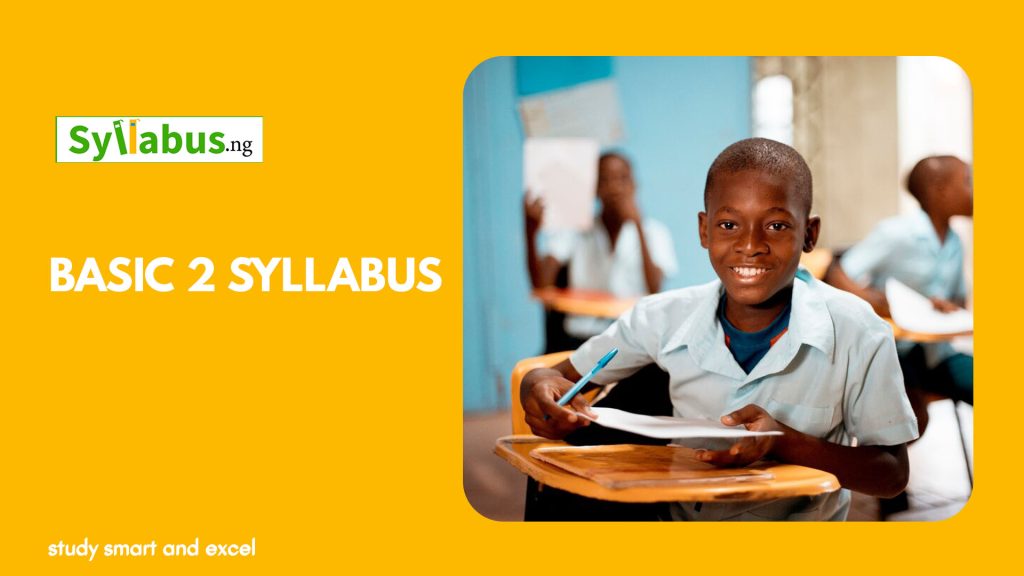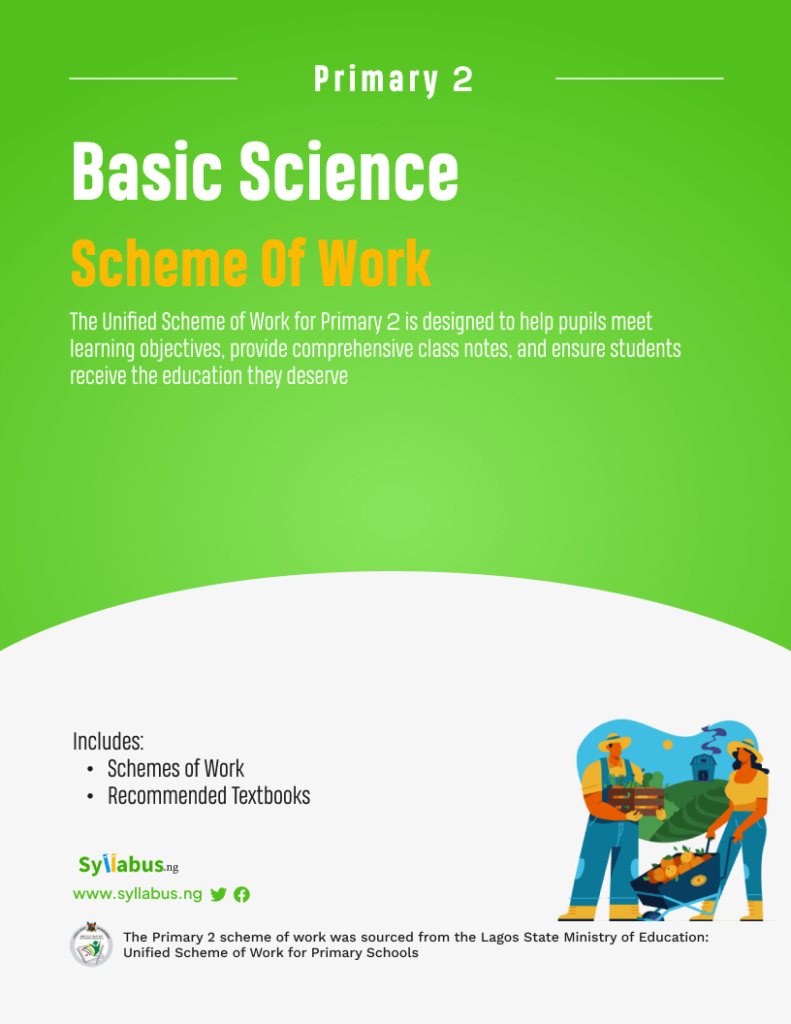Download the Unified Basic 2 Scheme of Work for Basic Science, to serve as a guide for educators and primary school teachers

Home » Primary 2 Scheme of Work » Primary 2 Basic Science Scheme of Work
The basic science for Primary two is a little bit more into science than the Primary 1 Basic Science. In this session, the scheme is also centered on Living things and Energy, but it covers the broader aspect of these topics.
The pupils will be taught topics like senses; hearing, smell, taste, touch. They will also be taught soil; sandy, loamy, and clay soil and they will be asked to mold with the soil. Topics like Plant, Animals, Energy, Colour and its use, Air, Water etc.
By the end of the session, the pupils are expected to know how to identify senses in humans, discuss soil types and their characteristics, practical use of clay soil, understand this concept of water, its properties and importance to living things etc. All these can be properly achieved with the aid of pupil-teacher interaction, and the use of the needed instructional material.

Know what’s expected of you as an educator
Download the Lagos State Unified Scheme of Work for Primary 2 Basic Science
| LAGOS STATE GOVERNMENT MINISTRY OF EDUCATION UNIFIED SCHEMES OF WORK FOR PRIMARY SCHOOLS | ||
| Basic Science Scheme of Work for Primary/Basic 2 | ||
| CLASS | Primary/Basic 2 | |
| SUBJECT | Basic Science | |
| TERM | First Term | |
| WEEK | TOPICS | Learning Objectives |
| 1 | Revision of Basic 1 work | |
| 2 | The Senses -Explain senses -Identify the senses -identify and match the organs of sense | At the end of the lesson, pupils should be able to: i- identify the senses ii. match each sense to its organs of sense iii. draw its organs of sense. |
| 3 | The senses-Sight -Meaning or sight -Identification of the eye as the organ of sight | At the end of the lesson, pupils should be able to: i. Use the sense of sight to observe and name various Objects around them in the classroom their shapes. co!our, and size; ii. appraise the importance of the eye as the sense of sight; |
| 4 | The scnses- Hearing The ear as the organ of sound -Dillerent sounds objects that produce sound -Importance of sound | At the end of the lesson, pupils should be able to i. identify the ear as the organ for receiving sounds ii. listen and idetltfy sounds differrnt animals and object in the environment; iii. differentiate between sounds of object, animals and humans; iv. appraise the importance of the sense of sound in their interaction with their environment |
| 5 | The senses-Smell -The nose as the organ of smell -Smell of different substance -Pleasant and unpleasant odour -Importance of smell | At the end of the lesson, pupils should be able to: i. Identify the nose as the organ of smell; ii. recognize the items (like fruits, food etc) through smelling; iii. describe the pleasant and unpleasant Odour; iv. associate odours with specific pleasant and unpleasant smell. v. Appraise the importance of nose/odours in daily activities |
| 6 | The senses- Taste -The tongue as the organ of taste Taste buds -Taste of substances | At the end of the lesson, pupils should be able to: i.identify the taste of different substances; ii.describe the types of taste of food substances; iii. distinguish between types of taste |
| 7 | MID-TERM ASSESSMENT | |
| 8 | The senses- Touch | At the end of the lesson, pupils should be able to i.detect the textures of various substances through touching and feeling; ii. identify the skin as the organ of touch; iii. distinguish between rough and coarse objects; cold and hot, etc. iv. assess the importance of the skin and the sense of touch to them |
| 9 | Meaning of soil Tvpcs of soil Water holding capacy of soil | At the end ot the lesson, pupils should be able to: i. identify soil locations within the school compound: ii. describc ‘the types of soil iii. compare clay soil and sandy soil through mouldings. iv. examine the watcr holding capacities of these soil types; |
| 10 | Sandy Soil -Meaning -Orgausms in the sample of soil -Propeties of sandy soil | At the end of the lesson, pupils be able m: i. collect and identify soil type (sandy); ii.examine to identify the organisms in the soil iii.describe the texture, colour and size cf the soil particles |
| 11 | REVISION | |
| 12 | EXAMINATION | |
| CLASS | Primary/Basic 2 | |
| SUBJECT | Basic Science | |
| TERM | Second Term | |
| WEEK | TOPICS | Learning Objectives |
| 1 | REVISION OF TERM WORK | REVISION OF TERM WORK |
| 2 | Loamy Soil -Meaning -Organisms in the sample of the soil -Properies of sandy soil | At the end ofthe lesson, pupils should be able to: i. collect and identify soil type (loamy); ii. examine to identify the organisms in the soil iii, describe the texture, colour and size ofthe soil particles |
| 3 | Clay Soil Meaning -Organisms in the sample of the soil -Properües of clay soil | At the end of the lesson, pupils should be able to: i. collect and identifysoil type(loamy) ii. examine to identifythe organisms in the soil iii. describe the texture, colour and size of the soil particles |
| 4 | Clay: -Meaning -Materials and procedures -Use of clay- moulding | Pupils should be able to: i. say the meaning of clay; ii. identify materials and procedures to make clay; iii. describe the use clay for moulding iv. explains what clay is used for |
| 5 | Clay- Practical -Molding with clay | At the end of the lesson, pupils should be able to: i. identify materials for moulding using clay, ii, Identify and describe items that can be moulded with clay; iii, mould objects with clay. |
| 6 | Plants -Features of plants -Groups of plants based on features | At the end of the lesson, pupils should be able to: i. locate and identify common plants in their school compound; ii. trace the leaves of plants on plasticine or clay; iii. examine the identified plants to describe their features (texture, shape, size and colour) of leaves; i iv, group plants based on their features |
| 7 | MID.TERM ASSESSMENT | |
| 8 | Plants -Common uses of plants -Groups of plants based on uses | At the end of the lesson, pupils should be able to: i. identify the common uses of plants (for food, beautification, building, furniture, shade; ii. medicine examine other uses of plants iii. group plants based on their uses |
| 9 | Animals -Common animals in the surroundings -Features of animals Behavior of animals -Groups animals | At the end of the lesson, pupils should be able to: i. locate and identify common animals in their school compound and surroundings ii. examine the observable features of animals iii. group plants based on their features and behaviour. |
| 10 | Animals Common uses of animals | At the end ofthe lesson, pupils should be able to: i. identify the common uses of animals (for food, bags, hide and skins, etc) ii. describe other uses of animals (making money, security, sport etc iii. explain the things needed for proper care of animals iv. demonstrate the correct ways of taking care of animals |
| 11 | REVISION | REVISION |
| 12 | EXAMINATION | |
| CLASS | Primary/Basic 2 | |
| SUBJECT | Basic Science | |
| TERM | Third Term | |
| WEEK | TOPICS | Learning Objectives |
| 1 | REVISION OF 2nd TERM WORK | REVISION OF 2nd TERM WORK |
| 2 | Forms of energy | At the end of the lesson, pupils should be able to: i. explain energy; ii. identify different forms of energy, iii. describe the uses of energy to man |
| 3 | Sound Energy: -Objects that produce sound instruments | At the end of the lesson, pupils should able to: i.identify sounds of different objects and animals; ii. mention various instruments that an make sound; iii. produce looal instrument that can make sounds: iv. create sound with any man-made instrument |
| 4 | Colour -Classifiation of objects using colour -Uses of colour | At the end ofdle kon, pupils åouldbe able to: i. identify different colours; ii. clasify objects using colouc iii. identify colours in living and non. living things; iv.discuss the uses of colours. v. appraise the importance of colours. |
| 5 | Air – Existence of Air -Meaning -Use ofair | At the end of the lesson, pupils should be able i. say meaning of air ii. identify the gases of air iii. demonstrate the air in nature iv. explain the use of air. |
| 6 | Air- floatation Objects that flow jn aar Make things that float in air | At the end of the lesson, pupils should be able to: i. mention objects that float in air; ii.identify the characters ot the objects that can float In air; iii. construct/make things (kites, blown balloons etc.) float or fly in air. |
| 7 | Mid-Term Assessment | |
| 8 | Water – Object that Float in water | At the end of the lesson, pupils should be able to: i. mention objects that float in water ii. describe the characteristics of object that float in water iii. demonstrate how to make objects float in water. |
| 9 | Water – Object that sink in water | At the end ofthe lesson, pupils should be able to: i.identify objects ffat sinkin water; ii. describe the characteristics of objects that flow in water iii. examine how heavy objects sinkin water, |
| 10 | Road user -Meaning of road -Road users Correct use of the road | Pupils should be able to. i. say the meaning of roads; ii. identify different road users (e.g. cars, bicycles, motor cycle, humans, animals etc) iii how each user correctly use road; |
| 11 | REVISION | |
| 12 | EXAMINATION | |
Basic Science
Main Text
Workbook
Teachers Guide

Know what’s expected of you as an educator
Download the Lagos State Unified Scheme of Work for Primary 2 Basic Science